|

by Dr. Susan Crockford
February 23,
2023
from
PolarBearScience Website
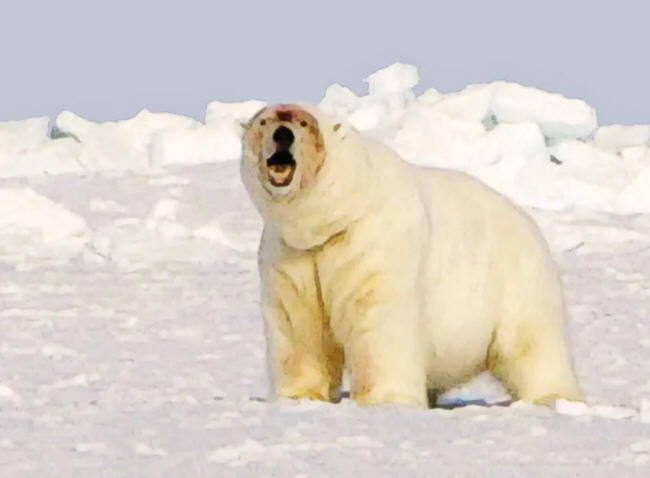
Enormously fat Chukchi Sea polar bear,
USFWS.
Published field study observations
- not population size -
prove
polar bears are thriving...
There is irrefutable evidence from Barents and Chukchi Sea
subpopulations, among others, that polar bears are fat and
reproducing well despite marked declines in summer sea ice over the
last two decades.
These indicators of
physical and reproductive health, in any species, are signs of
thriving populations.
However, these facts
negate the premise that polar bears require abundant summer sea ice
to flourish, and that creates a problem for polar bear specialists
who continue to make that claim (Amstrup et al. 2007; Crockford
2017, 2019).
In other words, the
assessment that polar bears are currently thriving is not
based solely on
estimates of a slight increase in
global population size but on published data gathered from field
studies on the bears' physical and reproductive health.
Oddly, biologists
repeatedly turn to data from
Western Hudson Bay to drive home to the public their
preferred message that polar bear health and abundance are being
negatively affected by recent summer sea ice declines.
However, they fail
to mention that robust field data from many other regions, including
the Barents and Chukchi Seas, support the opposite conclusion.
Moreover, wherever
possible, they mumble under their breath (or leave out entirely) the
fact that poor ice conditions could not be blamed for a 27% decline
in polar bear numbers in Western Hudson Bay since 2016 - because
their
own data showed sea ice conditions
had been strong!
Population
numbers
Polar bear
specialists refuse to update their 2015 global population estimate
of 26,000 to reflect recent subpopulation survey results but when
those data are taken into account (e.g. Conn et al. 2021; Dyck et
al. 2021, 2022; Matishov et al. 2014), the average global population
estimate comes to about 32,000 with a wide range of potential error.
Although this
modest increase is not statistically significant, it would likely
take a 50% increase over that 26,000 estimate to meet that
benchmark, considering that a recent 42% increase in Svalbard polar
bear abundance was deemed statistically insignificant (Aars et al.
2017).
Although a case has
been made that global numbers may indeed be as high as 39,000 (Crockford
2019),
that's not why polar bears are said to be thriving.
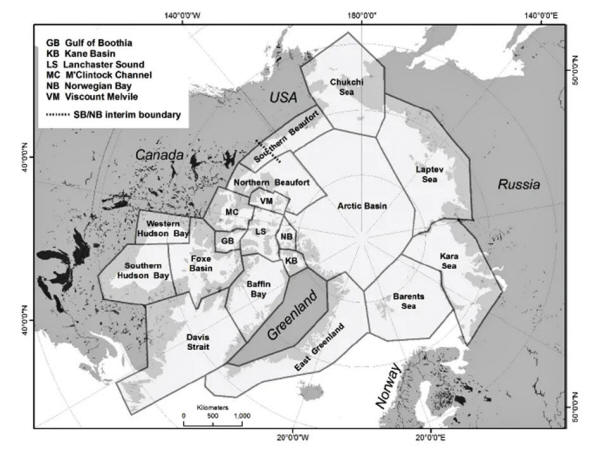
Barents
Sea/Svalbard
Spring research in Svalbard,
Norway in 2022 showed body condition of male polar bears was stable
and the number of females with cubs (both cubs-of-the-year and
one-year old cubs) were up compared to many previous years.
While many bears
have abandoned the Svalbard region for less volatile ice conditions
in the eastern Barents Sea around
Franz Josef Land, the 300 or so that remain are
still doing well (Aars 2015, 2018, 2022; Aars et al. 2017;
Anderson et al. 2012; Haavik 2022), despite having lost 5-6 times as
much summer ice as Western Hudson Bay (Lippold et al. 2019:988;
Regehr et al. 2016).
The graph below
shows that the number of females with
cubs-of-the-year (blue dots) and one-year-old cubs (red dots)
were both up slightly in 2022, although overall, neither metric had
a significant trend (declining or increasing) over time:
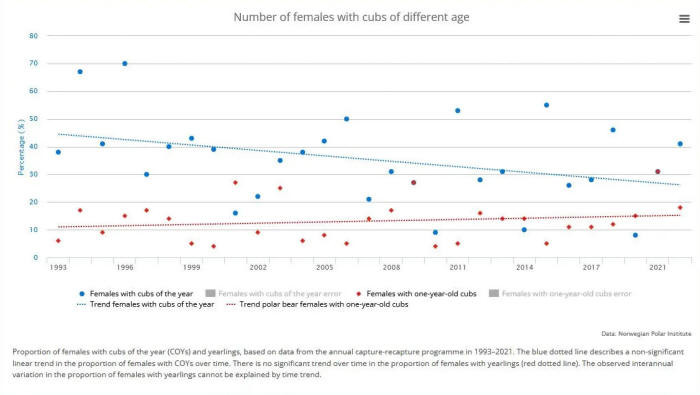
Body condition of
adult male bears shown below was down a bit in 2022 but not
significantly, and 2019 saw bears in the best condition
since
1995 (2020 data is missing):
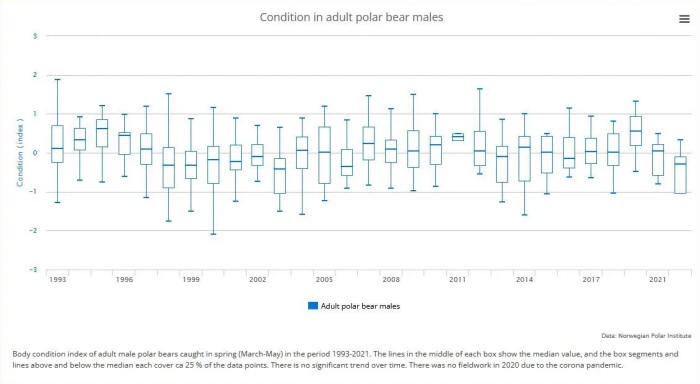
Body condition of
females is not presented in the annual records posted by Norwegian
researchers but Jon Aars stated in 2022 that females were in
excellent
condition, continuing the trend documented in a 2019 published
study (Lippold et al. 2019).
"Unexpectedly,
body condition of female polar bears
from the Barents Sea has increased after 2005,
although sea ice has retreated by
~50% since the late 1990s in the area, and the length of the
ice-free season has increased by over 20 weeks between 1979 and
2013.
These changes are also accompanied
by winter sea ice retreat that is especially pronounced in the
Barents Sea compared to other Arctic areas".
Lippold et al.
2019:988
Chukchi Sea
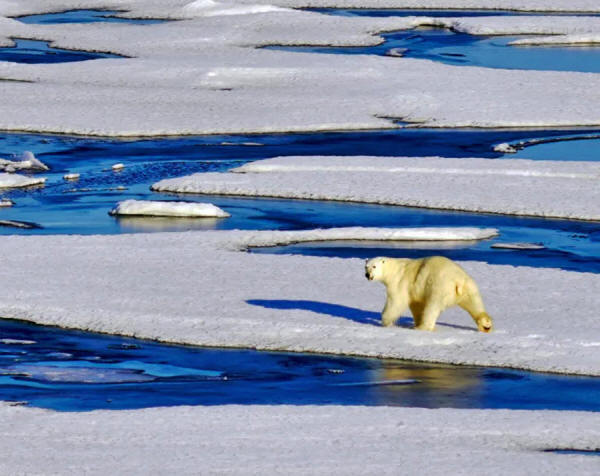
Chukchi Sea,
early August 2018.
An aerial survey of
the Chukchi Sea in 2016 generated a population estimate of 5,444
(range 3,636–8,152), about 2,500 greater than a previous survey
(Conn et al. 2021; Regehr et al. 2018).
Field studies found
Chukchi Sea bears have been in excellent condition and reproducing
well, and are not spending more time on land during the summer than
they did during the 1980s (Rode et al. 2014, 2018, 2021, 2022;
Wilson et al. 2016).
Reports in early
2022 that polar bears have been moving from Alaska to Russia in a 'mass
exodus' may describe a real phenomenon that reflects the
excellent feeding conditions for bears in the Chukchi Sea compared
to Alaska, fueled by continued increases in primary productivity
made possible by less summer sea ice (Frey et al. 2022).
The Chukchi Sea has
lost as much summer sea ice since 1979 as Western Hudson Bay (Regehr
et al. 2016).
"Chukchi bears remain larger and fatter and have not seen
downward trends in cub production and survival, according to new
preliminary information on the health and numbers of bears."
The Province, interview with
Eric Regehr,
2018
Other Thriving
Subpopulations
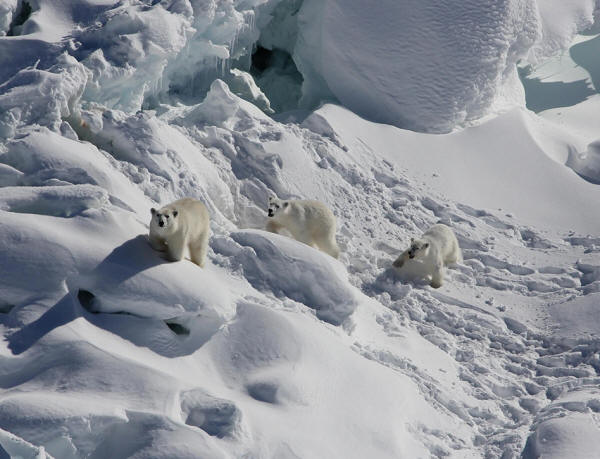
Fat SE Greenland female with yearly cubs.
Davis
Strait:
Results from
the 2017–2018 survey revealed most bears were fatter than they
had been in 2005-2007, with good cub survival; the authors found
no relationship between bear survival and summer sea ice
conditions, including number of ice-free days (Dyck et al.
2022).
M'Clintock Channel:
Dyck et al.
2021 found that by 2014-2016, this subpopulation in the central
Canadian Arctic had increased in abundance and body condition of
bears had improved since the previous study, likely due to
increased biological productivity.
Kane
Basin:
Field work by
polar bear specialist Kirstin Laidre and colleagues (2020) found
that numbers had not only
increased significantly (from about 224 to 357, a 59%
increase) but that bears were in excellent condition and
reproducing well.
"Our study provides evidence
for range expansion,
improved body condition, and stable reproductive performance
in the KB polar bear subpopulation.
These changes,
together with a likely
increasing subpopulation abundance, may reflect the
shift from thick, multiyear ice to thinner, seasonal ice
with higher biological productivity."
Laidre et al.
2020: abstract
Gulf of
Boothia:
Local Inuit
insist polar bears are
physically "robust" and abundant; a recent survey conducted
by biologists concluded the population was stable but noted
improved body condition since the previous study.
High survival
of adult females and cubs indicated "healthy reproduction"
despite the region having the
highest known density of bears anywhere in the Arctic (8.9
bears per 1,000km2) (Dyck et al. 2023).
Southeast Greenland:
Researchers
Kristin Laidre and colleagues discovered a
previously unknown subpopulation of about 234 polar bears
living in SE Greenland (below 64 degrees N) that are genetically
distinct and geographically isolated from East Greenland bears
to the north.
Photos
provided by the authors show fat bears at the end of summer
(see one above) and they state:
"Adult
female body mass, an important determinant of cub production
and survival, was lower in
Southeast Greenland than in several other subpopulations but
was similar to that of Northeast Greenland bears
and the Barents Sea
subpopulation, both of which use glacial fjords."
Laidre et al.
2022: 1334
Western Hudson
Bay
Not thriving but
not due to lack of sea ice. Far from being
representative of all subpopulations, it is an anomaly.
A Western Hudson
Bay survey conducted in 2021 revealed a 27% decline in polar bear
abundance over the previous five years but the information released
to the media in
late December 2022 (still no report publicly available) admits
that reduced summer sea ice conditions
could not be responsible for this population decline because sea
ice conditions had been
"moderately good" for four out of five years.
This is surely an
understatement, as
another study found no temporal trend in sea ice or
departure dates of polar bears from shore between 1991 and
2020 (Miller et al. 2022) and in several years,
preliminary information on departure dates suggest they were as
early as they had been in the 1980s.
No details about
the body condition of WH bears were released to the media to
substantiate the implication that large numbers of bears could have
starved to death between 2017 and 2021.
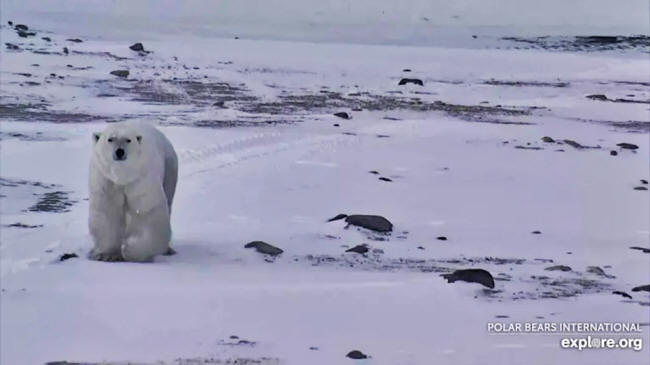
Wapusk National Park,
Western Hudson Bay,
4 November 2020.
Conclusion
Polar bears in most
studied subpopuatlions that have been recently assessed (seven so
far) are in good or excellent body condition and reproducing well...
These are known
indicators of a thriving species. The evidence to date shows that
declines in summer sea ice have not been
detrimental to polar bear health and survival.
On the contrary, in
virtually all areas, much less sea ice has been beneficial:
the
opposite of what polar bear 'models' predicted would happen.
Thriving
subpopulations prove there is no "immediate existential threat
to the entire species," as the chief research scientist from
activist organization
Polar Bears International would have the public believe:
"It is both simultaneously true to
point to part of recent history and say there's a conservation
success story here, and that should rightfully be celebrated,
and to also say there's an
immediate existential threat to the entire species right now,"
said John Whiteman, chief research scientist for Polar Bears
International.
2 December 2022,
It's misleading to claim that polar bears are 'thriving' because
of 'increasing population'
References
-
Aars, J. 2015.
Research on polar bears at Norwegian Polar Institute.
Online seminar ('webinar"), January 14. pdf
here.
-
Aars, J. 2018.
Population changes in polar bears: protected, but quickly
losing habitat. Fram Forum Newsletter 2018. Fram
Centre, Tromso. Download pdf
here (32 mb).
-
Aars, J. 2022.
'Receding ice poses threat to polar bears.' Norwegian
Polar Institute,
Youtube, 6 May.
-
Aars, J., Marques,T.A, Lone, K., et al. 2017.
The number and distribution of polar bears in the western
Barents Sea. Polar Research 36:1. 1374125. doi:10.1080/17518369.2017.1374125
-
Amstrup, S.C., Marcot, B.G. & Douglas, D.C. 2007.
Forecasting the rangewide status of polar bears at selected
times in the 21st century. US Geological Survey.
Reston, VA. Pdf
here
-
Andersen, M., Derocher, A.E., Wiig, Ø. and Aars, J. 2012.
Polar bear (Ursus maritimus) maternity den
distribution in Svalbard, Norway. Polar Biology
35:499-508.
-
Conn, P.B., Chernook, V.I., Moreland, E.E., et al. 2021.
Aerial survey estimates of polar bears and their tracks in
the Chukchi Sea. PLoS ONE 16(5): e0251130.
https://doi.org/10.1371/journal.pone.0251130
-
Crockford, S.J. 2017.
Testing the hypothesis that routine sea ice coverage of 3-5
mkm2 results in a greater than 30% decline in population
size of polar bears (Ursus maritimus). PeerJ
Preprints 19 January 2017. Doi:
10.7287/peerj.preprints.2737v1 Open access.
https://peerj.com/preprints/2737/
-
Crockford, S.J. 2019.
The Polar Bear Catastrophe That Never Happened.
Global Warming Policy Foundation, London. Available in
paperback and
ebook formats.
-
Dickie, G. 2022.
'Canada's Hudson Bay polar bear population plummets as
climate change warms Arctic'. Reuters, 23 December.
https://www.reuters.com/world/americas/canadas-hudson-bay-polar-bear-population-plummets-climate-change-warms-arctic-2022-12-23/
-
Dyck, M., Lukacs, P.M.and Ware, J.V. 2021.
Recovery from reduction: M'Clintock Channel polar bear
subpopulation, Nunavut, Canada. Arctic
74(4):509-524.
-
Dyck, M., Dunham, K.D., Ware, J.V., et al. 2022.
Re-estimating the abundance of the Davis Strait polar bear
subpopulation by genetic mark-recapture. Final Report
[amended 9 May 2022], Government of Nunavut, Department of
Environment, Iglulik.
-
Dyck, M., Regehr, E.V. and Ware, J.V. 2023.
Demographic assessment using physical and genetic sampling
finds stable polar bear subpopulation in Gulf of Boothia,
Canada. Marine Mammal Science 39:151-174.
-
Frey, K.E., Comiso, J.C., Cooper, L.W., et al. 2022.
Arctic Ocean primary productivity: the response of marine
algae to climate warming and sea ice decline. 2022 NOAA
Arctic Report Card,
https://doi.org/10.25923/0je1-te61
-
Haavik, E. 2022.
'Svalbard's polar bears persist as sea ice melts - but not
forever.
The World, 21 July.
-
Laidre, K.L., Atkinson, S.N., Regehr, E.V., et al. 2020.
Transient benefits of climate change for a high‐Arctic polar
bear (Ursus maritimus ) subpopulation. Global
Change Biology 26(11):6251-6265.
DOI:
10.1111/gcb.15286 [paywalled]
-
Laidre, K.L., Supple, M.A., Born, E.W., et al. 2022.
Glacial ice supports a distinct and undocumented polar bear
subpopulation persisting in late 21st century sea-ice
conditions. Science 376 (6599): 1333-1338.
https://www.science.org/doi/10.1126/science.abq5267
-
Lippold, A., Bourgeon, S., Aars, J., et al. 2019.
Temporal trends of persistent organic pollutants in Barents
Sea polar bears (Ursus maritimus) in relation to
changes in feeding habits and body condition.
Environmental Science and Technology 53(2):984-995.
-
Matishov, G.G., Chelintsev, N.G., Goryaev, Yu. I., et al.
2014.
Assessment of the amount of polar bears (Ursus maritimus)
on the basis of perennial vessel counts. Doklady Earth
Sciences 458 (2):1312–1316.
-
Miller, E.N., Lunn, N.J., McGeachy, D., and Derocher, A.E.
2022. Autumn
migration phenology of polar bears (Ursus maritimus)
in Hudson Bay, Canada. Polar Biology 45:1023-1034.
-
Regehr, E.V., Hostetter, N.J., Wilson, R.R., et al. 2018.
Integrated population modeling provides the first empirical
estimates of vital rates and abundance for polar bears in
the Chukchi Sea. Scientific Reports 8 (1) DOI:
10.1038/s41598-018-34824-7
https://www.nature.com/articles/s41598-018-34824-7
-
Regehr, E.V., Laidre, K.L, Akçakaya, H.R., et al. 2016.
Conservation status of polar bears (Ursus maritimus)
in relation to projected sea-ice declines. Biology
Letters 12: 20160556.
http://rsbl.royalsocietypublishing.org/content/12/12/20160556
Supplementary data
here.
-
Rode, K.D., Douglas, D.C., Atwood, T.C., et al. 2022.
Observed and forecasted changes in land use by polar bears
in the Beaufort and Chukchi Seas, 1985-2040. Global
Ecology and Conservation 40: e02319.
https://doi.org/10.1016/j.gecco.2022.e02319
-
Rode,
K.D., Olson, J., Eggett, D., et al. 2018. Den
phenology and reproductive success of polar bears in a
changing climate. Journal of Mammalogy 99(1):16-26.
here.
-
Rode, K. D., Regehr, E.V., Bromaghin, J. F., et al. 2021.
Seal body condition and atmospheric circulation patterns
influence polar bear body condition, recruitment, and
feeding ecology in the Chukchi Sea. Global Change
Biology 27:2684–2701.
https://doi.org/10.1111/gcb.15572
-
Rode, K.D., Regehr, E.V., Douglas, D., et al. 2014.
Variation in the
response of an Arctic top predator experiencing habitat
loss: feeding and reproductive ecology of two polar bear
populations. Global Change Biology 20(1):76-88.
http://onlinelibrary.wiley.com/doi/10.1111/gcb.12339/abstract
-
Wilson, R.R., Regehr, E.V., Rode, K.D., and St. Martin, M.
2016.
Invariant polar bear habitat selection during a period of
sea ice loss. Proceedings of the Royal Society B
283:20160380.
|








